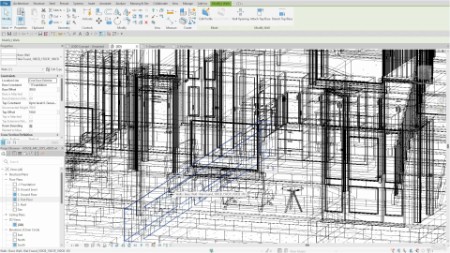Most Commented
Autodesk Revit Essentials (2025) – Beginner To Intermediate




Description material

Autodesk Revit Essentials 2025 – Beginner To Intermediate
Published 11/2024
MP4 | Video: h264, 1920x1080 | Audio: AAC, 44.1 KHz
Language: English | Size: 2.83 GB | Duration: 4h 51m
Unlock Revit 2025: Beginner to Intermediate Tools for Architecture and Design
What you'll learn
Learn To Generate 2d Drawings, Including Plans, Sections, And Elevations, Directly From Your 3d Model.
Learn How To Create Revit Families. How To Setup Parametric Relationships Within Your Designs
Learn How To Create Topographical Surfaces And Model Components
Learn Advanced Visualisation Using Twinmotion
Manage Design Alternatives Within A Single Revit File Using Design Option
Learn Revit's User Interface Including Navigation, Selection And Shortcuts
Requirements
Computer capable of running Autodesk Revit
Autodesk Revit
Description
Autodesk Revit Essentials 2025 – Beginner to IntermediateWhether you're completely new to Autodesk's Revit software or looking to solidify your skills, this course is the perfect starting point.Designed for beginners, the course provides a solid foundation in Revit, covering everything from navigating the interface to mastering essential tools. Best of all, it's project-based — you'll gain hands-on experience by working through every aspect of a real-world project.No prior experience with Revit? No problem! Each step is carefully recorded in detailed videos, ensuring you don't miss a thing. By following along, you'll develop practical skills and the confidence to tackle your own architectural designs.We'll begin with installing Revit, followed by an in-depth exploration of the interface, including navigation, snapping, and selection tools. From there, we'll build on these basics as you progress through the project, learning key workflows and best practices along the way.We'll start by adding foundations, ensuring your house has a solid base. Next, we'll move on to walls, where you'll explore different types of walls, their properties, and how to customize them to suit your design. With the walls in place, we'll create floors and ceilings, this will include working with levels and using Revit's tools to handle multi-story projects seamlessly.We'll design stairs, covering straight runs. You'll also add railings and learn how to customize them to follow a path. Next, we'll construct the roof, adding fascia, soffits, and gutters.We'll then install doors and windows, where you'll learn to insert, customize, and position these elements accurately. After this, you'll gain insight into family creation, where you'll build custom window components.To explore alternative solutions, we'll look into design options, teaching you how to propose and manage multiple design iterations within a single project file.We'll tackle massing and site tools, where you'll create the surrounding environment for your model.As your design comes together, we'll generate room schedules, legends, add dimensions and prepare your project for presentation and documentation. These essential tools will help you automate data, organize your project, and enhance your understanding of Revit's documentation capabilities ready for precise communication with stakeholders and contractors.To conclude, we'll take your fully realized project into Twinmotion through direct linking, enabling you to visualize your design in stunning detail. You'll learn how where to set up realistic lighting, materials and assets culminating in a beautifully rendered scene ready for clients or your portfolio.Topics Covered:Revit Home ScreenOpening FilesQuick Access ToolbarRibbonThe Architecture TabProperties PaletteProject BrowserView Control BarView ScaleDetail Level (Coarse, Medium, Fine)Visual Styles (Wireframe, Hidden Line, Realistic, Consistent Colors)Graphic Display OptionsSun SettingsShadows OffShow Rendering DialogueCrop ViewShow Crop RegionUnlocked 3D ViewSaveOrientation and Lock ViewTemporary Hide/IsolateHide CategoryIsolate ElementIsolate CategoryReset Temporary Hide/IsolateReveal Hidden ElementsTemporary View PropertiesShow Analytical ModelHighlight Displacement SetsReveal ConstraintsStatus BarWorksetsDesign OptionsSelect LinksSelect Underlay ElementsSelect Pinned ElementsSelect Elements by FaceElements on SelectionPanningZoomingLock to SelectionPerspectiveOrthographicOrient to ViewFull Navigation WheelZoom RegionNavigation BarFlySnap IncrementAngular IncrementObject SnapsCycle Through SnapsSingle Click SelectionsRemoving Objects from SelectionWindow SelectionCrossing SelectionTab Key SelectionFilter Selectionselection Box ToolSelection SetsSelect by IDsSelect by FaceArchitectural TemplateProject InformationProject UnitsProject LocationSaving a Revit FileNaming ConventionBackupsLinking CAD FilesSelect LinksPinningAlignElevation ViewsLevelsAdd ElbowCreate Plan ViewContextual TabAuto-JoinAuto-Join & LockPlacement OptionsWall AssemblyFunctionMaterialCore BoundaryPlacementCentre to CentreWall FoundationsFootingsFloor ArchitecturalPick WallsSplit ElementSketch CeilingAutomatic CeilingRiser HeightTread DepthModifying BoundaryFascia and SoffitProfile CreationAlignment and PlacementGuttersModel in PlaceCreating Custom Revit FamiliesApplying Gutter ProfilesModifying and Loading Family ComponentsParameter ModificationsPipe Alignment AdjustmentsObject Duplication and PlacementRevit FamiliesDoor PlacementDimension EditingType DuplicationRevit Families CreationSweep Tool UsageConstraining GeometryExtrusion ToolCreate and Align Reference PlanesConstrain with Align and Dimension ToolsApply Materials to Window ElementsSill ExtrusionConstrainFamily TypesManipulate Tiled ViewAdd Furniture ComponentsAdjust Component AlignmentDesign OptionsOption SetPrimary OptionSecondary OptionToposolid from SketchModify Sub ElementElevation PointsBuilding PadSeparating RoadwayForming FootpathsSchedulesCrop RegionRoom LegendAligned DimensionsLinear DimensionsAngular DimensionsRadial DimensionsDiameter DimensionsArc Length DimensionsSpot ElevationSpot CoordinateSpot SlopeVisibility/Graphics OverridesDimension and Annotation ToolsSheets SetupGuide GridPrint PreparationDirect Link SynchronizationHow to Export to TwinmotionNavigation ControlsApplying MaterialsScaling and UV AdjustmentsReplacing ModelsImage RenderingSaving ImageBy the end of this course, you'll not only have a completed house model but also the skills to bring your architectural ideas to life in Revit. Enroll now and start shaping the future of design with Revit!
Overview
Section 1: Introduction
Lecture 1 Introduction
Lecture 2 Where And How To Get Revit
Lecture 3 Installing Library Files
Lecture 4 Revit Home Screen, Opening Files and the Quick Access Toolbar
Lecture 5 Ribbon, The Architecture tab, Properties Palette, Project Browser
Lecture 6 View Control Bar, and Assigning Shortcuts
Lecture 7 Worksets, Design Options, Select Links, Select Underlay Elements, Select Pinned
Lecture 8 Panning, Zooming, Recentre, Lock to Selection, Perspective, Orthographic
Lecture 9 Snap Increment, Angular Increment, Object Snaps, Cycle Through Snaps
Lecture 10 Single Click selections, Removing Objects from Selection, Window Selection
Section 2: Building Project in Revit
Lecture 11 Architectural Template, Project Information, Project Units, Project Location
Lecture 12 Linking CAD Files, Select Links, Pining, Align
Lecture 13 Elevation Views, Levels, Add Elbow, Create Plan View
Lecture 14 Contextual Tab, Auto-Join, Auto-Join & Lock, Placement Options
Lecture 15 Wall Assembly, Function, Material, Core Boundary, Placement
Lecture 16 Internal Walls - Centre to Centre
Lecture 17 Wall foundations, Footings
Lecture 18 Floor Architectural, Pick Walls, Split Element
Lecture 19 Sketch Ceiling, Automatic Ceiling
Lecture 20 Stairs - Riser Height, Tread Depth, Modifying Boundary
Lecture 21 Roof By Footprint, Trim/Extend To Corner, Edit Footprint
Lecture 22 Fascia And Soffit, Profile Creation, Alignment And Placement
Lecture 23 Gutters, Model In Place, Creating Custom Revit Families, Applying Gutter Profile
Lecture 24 Component, Parameter Modifications, Pipe Alignment Adjustments
Lecture 25 Revit Families, Door Placement, Dimension Editing, Type Duplication
Lecture 26 Revit Families Creation, Sweep Tool Usage, Constraining Geometry
Lecture 27 Extrusion Tool, Create And Align Reference Planes
Lecture 28 Sill Extrusion, Constraining
Lecture 29 Family Types
Lecture 30 Manipulate Tiled View, Add Furniture Components, Adjust Component Alignment
Lecture 31 Design Options, Option Set, Primary Option, Secondary Option
Lecture 32 Toposolid from Sketch, Modify Sub Element, Elevation points
Lecture 33 Separating roadway, driveway and Forming Footpaths
Lecture 34 Schedules, Crop Region, Room Legend
Lecture 35 Aligned Dimensions, Linear dimensions, Angular Dimensions, Radial dimensions
Lecture 36 Visibility/Graphics Overrides, Dimension and Annotation Tools
Lecture 37 Sheets Setup, Guide Grid, View Alignment, Print Preparation
Section 3: Rendering in Twinmotion
Lecture 38 Twinmotion Setup, Direct Link Synchronization, How to Export to Twinmotion, Navi
Lecture 39 Applying Materials, Scaling And UV Adjustments, Replacing Models
Lecture 40 Image Rendering, Camera Adjustments, Saving Image
Beginners to intermediate skill level,Architects, Designers, Landscaper. Designers, Contractors,Students

Download
Fikper
https://fikper.com/zIcQXZ01i8/.Autodesk.Revit.Essentials.2025.-.Beginner.To.Intermediate.part1.rar.html
https://fikper.com/eIBuxx5AYU/.Autodesk.Revit.Essentials.2025.-.Beginner.To.Intermediate.part2.rar.html
FileAxa
https://fileaxa.com/u8cwqodbd8m9/.Autodesk.Revit.Essentials.2025.-.Beginner.To.Intermediate.part1.rar
https://fileaxa.com/f3xnwrwoemj0/.Autodesk.Revit.Essentials.2025.-.Beginner.To.Intermediate.part2.rar
RapidGator
https://rapidgator.net/file/acf3cc4f11455cdaa1d7f2ab817374e1/.Autodesk.Revit.Essentials.2025.-.Beginner.To.Intermediate.part1.rar
https://rapidgator.net/file/44e76083dc8b49ad93ad8dfaaf2763c0/.Autodesk.Revit.Essentials.2025.-.Beginner.To.Intermediate.part2.rar
FileStore
TurboBit
https://turbobit.net/g0z4x0iclwre/.Autodesk.Revit.Essentials.2025.-.Beginner.To.Intermediate.part1.rar.html
https://turbobit.net/qpzylfieyppz/.Autodesk.Revit.Essentials.2025.-.Beginner.To.Intermediate.part2.rar.html
Rapidgator links are free direct download only for my subscriber, other hosts are free download for free users
Fikper
https://fikper.com/zIcQXZ01i8/.Autodesk.Revit.Essentials.2025.-.Beginner.To.Intermediate.part1.rar.html
https://fikper.com/eIBuxx5AYU/.Autodesk.Revit.Essentials.2025.-.Beginner.To.Intermediate.part2.rar.html
FileAxa
https://fileaxa.com/u8cwqodbd8m9/.Autodesk.Revit.Essentials.2025.-.Beginner.To.Intermediate.part1.rar
https://fileaxa.com/f3xnwrwoemj0/.Autodesk.Revit.Essentials.2025.-.Beginner.To.Intermediate.part2.rar
RapidGator
https://rapidgator.net/file/acf3cc4f11455cdaa1d7f2ab817374e1/.Autodesk.Revit.Essentials.2025.-.Beginner.To.Intermediate.part1.rar
https://rapidgator.net/file/44e76083dc8b49ad93ad8dfaaf2763c0/.Autodesk.Revit.Essentials.2025.-.Beginner.To.Intermediate.part2.rar
FileStore
TurboBit
https://turbobit.net/g0z4x0iclwre/.Autodesk.Revit.Essentials.2025.-.Beginner.To.Intermediate.part1.rar.html
https://turbobit.net/qpzylfieyppz/.Autodesk.Revit.Essentials.2025.-.Beginner.To.Intermediate.part2.rar.html
Rapidgator links are free direct download only for my subscriber, other hosts are free download for free users
Join to our telegram Group
Information
Users of Guests are not allowed to comment this publication.
Users of Guests are not allowed to comment this publication.
Choose Site Language
Recommended news
Commented



![eM Client Pro 9.2.1735 Multilingual [Updated]](https://pikky.net/medium/wXgc.png)






![Movavi Video Editor 24.0.2.0 Multilingual [ Updated]](https://pikky.net/medium/qhrc.png)

